The mission of NSTA is to promote excellence and innovation in science teaching and learning for all.
Future NSTA Conferences
STEM Forum & Expo
2017 Fall Conferences
National Conference
Follow NSTA
By Mary Bigelow
Posted on 2017-04-25
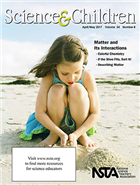
Two articles of interest to all K-12 teachers:
Science & Children – Matter and Its Interactions
Feature articles in this issue focus on how to introduce young students to the characteristics and properties of matter and Small Pieces of Matter. The lessons described in the articles include connections with the NGSS.
For more on the content that provides a context for projects and strategies described in this issue, see the SciLinks topics Chemical Reactions, Classification, Clouds, Matter, Mixtures, pH Scale, States of Matter, Water Cycle
Continue for Science Scope and The Science Teacher.
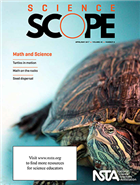 Science Scope – Math and Science
Science Scope – Math and Science
“Why are we doing math in science class?” my students would ask. But they soon realized that math could be applied to other subject areas such as science, especially in terms of measurement, graphing, and data analysis. As the Editor notes, two of the NGSS science and engineering practices are related to math. The featured articles this month encourage this relationship.
Articles in this issue that describe lessons include a helpful sidebar (“At a Glance”) documenting the big idea, essential pre-knowledge, time, and cost. The lessons also include connections with the NGSS.
For more on the content that provides a context for projects and strategies described in this issue, see the SciLinks topics Animal Behavior, Biodiversity, Density, Forces and Motion, Heat Transfer, Law of Conservation of Energy, Math and Science, Seeds, Temperature and Heat, Velocity, Whales
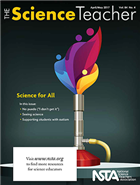 The Science Teacher – Science for All
The Science Teacher – Science for All
TST’s Editor this month quotes NSTA’s position on multicultural science education and notes “In our diverse classrooms, we must champion ideals of inclusion and allow all people to feel valued and safe.” This month’s issue has featured articles with ideas to deal with the differences in ethnicity, socioeconomic status, gender, physical disabilities, learning differences, and various levels of English proficiency in our classrooms.
The lessons described in the articles include connections with the NGSS.
For more on the content that provides a context for projects and strategies described in this issue, see the SciLinks topics Biodiversity, Biomolecules, Conservation of Matter, Invasive Species, Matter and Energy, Nutrition, Water Pollution, Watersheds, Worms

Two articles of interest to all K-12 teachers:
NGSS / 3-D Learning Blog
By Cindy Workosky
Posted on 2017-04-25
Knowing that content material is most engaging when students can relate to it, I always begin my year with a student survey. The questions are designed to help me design lessons to be as student-focused as possible. Knowing my students’ interests and history also helps me identify phenomena and storylines that will be the most engaging for them. The phenomenon is the hook to capture students’ interest and inspire their curiosity; storylines provide links between performance expectations. The combinations of phenomena and Performance Expectations are virtually endless.
I write my units using my own template which is a hybrid of Understanding by Design and Universal Design for Learning. Click here to view and download my template
Pre-planning: I recommend you bundle Performance Expectations into a logical storyline and include driving questions to guide students toward conceptual leaps. For example, when learning the fact that all cells come from existing cells, I expect a student to ask about the origin of the first cell. I use these questions to devise investigations that will help students find answers and develop their own questions. Asking probing questions during these activities is critical. I recommend you plan ahead and make your questioning targeted and intentional so that it causes students to think deeply and make sense for themselves.
Two tools I have found that are helpful include a Talk Activities Flowchart developed by STEM Teaching Tools and Goals for Productive Discussions and Nine Talk Moves published by TERC.
Let me share the stages I go through when I begin planning my science instruction.
Stage 1: Determine “All, Most, Few.” In this first stage, I differentiate the concepts and skills that all students need to achieve, the higher concepts and skills most will reach, and the extension activities I can provide to students who have advanced skills and interests. I then write two-to-four essential questions that make intentional reference to Crosscutting Concepts, scaffold my unit from lower- to higher-order thinking using Disciplinary Core Ideas, and determine which Science and Engineering Practices will be addressed and what skills I will target.
Stage 2: Looking for Evidence. Daily formative assessments inform instruction and guide my lesson planning. Formative assessments range from observations and discussions to tracked response assignments like Plickers, Quizzizz, Kahoot, EdPuzzle and Quizlet. Summative assessments are more time-intensive and require students to demonstrate their learning independently. These assessments differ between students and include poster presentations, informational website development, TED-style talks, and student-created lessons to teach younger students. To ensure I am encouraging 21st century and literacy skills, I also include a variety of digital and research components, time for modeling and reflection, and include elements of publishing or presentation for both formative and summative assessments.
Stage 3: The Blueprint. This final stage involves drafting a rough learning plan that includes critical input and inquiry lessons. I provide notes and other introductory presentations that help guide students and provide essential knowledge for the unit. Most of the lessons are student-centered and inquiry-based.
Taking it into the classroom:
Because I teach in a science lab with immovable lab benches, I’ve added a variety of seating options to facilitate collaboration and peer review among students and allow me to split the class into stations. The set-up includes two large round tables with chairs and a set of modular sofa sections.
I love to teach in stations! Students can be break into groups which facilitates differentiation and makes it possible for me to support the “all, most, few” idea presented in Stage 1.
My favorite resource when I first started planning 3-dimensional units includes the NSTA Press® book, Translating the NGSS for Classroom Instruction by Rodger Bybee. Click here to view a sample chapter.
My favorite resource for three-dimensional planning support comes from the American Museum of Natural History. Click here to view and download it.

Bonnie Nieves
Bonnie Nieves is the Science Department Chair at Millbury Memorial Jr./Sr. High School in Millbury, Massachusetts. She began her career in education as a paraprofessional specializing in science instruction for special needs students. This experience gave her a deep understanding of the importance of differentiation and its impact on student success. She is currently focused on developing ways to increase student engagement with phenomena-based instruction and supporting colleagues as they learn about and implement three-dimensions teaching.
Visit NSTA’s NGSS@NSTA Hub for hundreds of vetted classroom resources, professional learning opportunities, publications, ebooks and more; connect with your teacher colleagues on the NGSS listservs (members can sign up here); and join us for discussions around NGSS at an upcoming conference.
The mission of NSTA is to promote excellence and innovation in science teaching and learning for all.
Future NSTA Conferences
National Conference
Follow NSTA
Knowing that content material is most engaging when students can relate to it, I always begin my year with a student survey. The questions are designed to help me design lessons to be as student-focused as possible. Knowing my students’ interests and history also helps me identify phenomena and storylines that will be the most engaging for them. The phenomenon is the hook to capture students’ interest and inspire their curiosity; storylines provide links between performance expectations. The combinations of phenomena and Performance Expectations are virtually endless.
By Cindy Workosky
Posted on 2017-04-25
This month’s Digging Deeper column for the Next Gen Navigator focuses on the practice of constructing explanations and designing solutions, and specifically the design process that addresses the engineering component of the Next Generation Science Standards (NGSS). Its inclusion is relatively new in science education, and for teachers who haven’t had the opportunity to develop understanding of the engineering design process through workshops or teacher preparation coursework, it’s often viewed with trepidation.
The Framework for K–12 Science Education, the foundation of the NGSS, defines engineering as any “engagement in a systematic practice of design to achieve solutions to particular human problems.” The inclusion of the design process enables students to engage in the practical application of science knowledge to solve problems. It makes science relevant and meaningful to students. This relevancy makes learning engaging, and we know students learn when they are engaged and having fun! I think this is what makes the NGSS, and its inclusion of designing solutions, so powerful.
My journey into the engineering design process began almost 10 years ago when I was awarded a grant to purchase LEGO Mindstorms for my gifted and talented students. I had the wherewithal then to align the program to standards, guide my students to create their own challenge, and identify criteria for success. At the time, however, the science standards consisted only of the scientific and technological design processes. The technological design standard was simply stated as design, modify, and apply technology to effectively and efficiently solve problems. While the students no doubt were following this iterative process, they lacked an understanding of engineering design to facilitate their learning.
In addition, no standards addressed forces and interactions, and the crosscutting concepts of cause and effect, structure and function, and systems and systems models. I can only imagine how much more effective the students would have been with the iterative process if they had these key core ideas and crosscutting concepts to inform their design choices. (This actually emphasizes how the three dimensions work together to support learning, but that is a discussion for another blog post.)

learning the physical properties of magnets
While I still work directly with students, much of my time is now spent on professional development and coaching teachers. As a part of this work and as an NGSS@NSTA Curator, I have developed and field-tested a unit titled “What’s the Attraction?” Students begin this unit by engaging in the phenomenon of a “Magic Jar” in which a clip appears to be hovering in midair. Students are given the opportunity to ask questions based on the phenomenon observed, and because they’re always smarter than we give them credit for, one will invariably ask, “Is there a magnet in the cover of the jar?” Students then conduct a series of investigations to learn the physical properties of magnets, as well as the cause- and-effect relationships of magnetic interactions between two objects not in contact with one another (3-PS2-3).
Students are then presented with a performance task to define and solve a very real problem where we live and to apply their understanding of magnetic interactions. They are asked to design a device that can retrieve a set of keys that have fallen from a pier into the ocean (3-PS2-4). Using NASA’s Best Engineering Design Process, students ask questions to define a simple design problem based on criteria and constraints, generate and compare multiple solutions, and conduct fair tests in which variables are controlled and failure points are considered (3-5-ETS1-3). Here you see students designing their prototypes, standing on the “pier” to test their design solutions and a close-up of a prototype.

designing prototypes

standing on a “pier”
You can see the application of magnetic properties and reasoning for their design choices in this prototype: Ring magnets were the strongest among the magnet types available to them, and stacking them increased their ability to attract the keys without contacting them. The ring magnets were also small enough to maneuver easily between the rocks. The students were so engaged by this challenge that they begged their teacher to reiterate their designs a third time. With classroom instructional time for science at a premium, the teacher of this class set up a center where students could continue to improve and test their devices in their spare time.
This unit was also presented at the NGSS@NSTA Share-a-Thon held during the 2016 NSTA National Conference in Nashville, and generated suggestions to include scenarios of keys lost in a farm field or dropped through a subway grate.
Designing solutions with students is a teaching joy, and student-driven investigations are now easily accomplished, but my NGSS journey is far from over. What I still have to work on is facilitating students in the actual planning of their investigations. Even as a coach and a professional developer, I am still an NGSS learner.
I hope my journey will encourage you to continue on yours. Furthermore, I hope the unit I shared provided a concrete glimpse of what NGSS implementation looks like, and that it might spark ideas about how you could do it in your own classroom. They say a journey of a thousand miles begins with a single step, so go ahead: You can do it.

Karen Umeda
Karen Umeda is a STEM Coordinator at Momilani Elementary School in Pearl City, Hawaii, and an NGSS@NSTA Curator. She is also a Project Coordinator for the Mauna Kea Scholars Program and works with a team of teachers to deliver professional development on the “Wonders of Science and STEM,” a state-supported initiative.
The mission of NSTA is to promote excellence and innovation in science teaching and learning for all.
Future NSTA Conferences
National Conference
Follow NSTA
This month’s Digging Deeper column for the Next Gen Navigator focuses on the practice of constructing explanations and designing solutions, and specifically the design process that addresses the engineering component of the Next Generation Science Standards (NGSS).
NGSS / 3-D Learning Blog
By Cindy Workosky
Posted on 2017-04-25
When I first started teaching science, I taught the facts. I taught the nine planets (before Pluto got demoted; sorry, Pluto!), the steps of mitosis, and the workings of plate tectonics, for example. I was proud that I had students who could learn the facts and recite them to me. It was always wonderful to have my students perform well on their tests, and it made me smile to know they could identify things like the various Moon phases.
More recently, however, I noticed I was becoming more worried about my students’ ability to “do science,” not just learn about it. I became more intent on helping my students learn about the process, the nature of science. I was very encouraged when I heard new science standards were being developed that recommended exactly what I was trying to accomplish. I thought, “Hey, I do this already.” Then I began exploring the Next Generation Science Standards (NGSS), and thought, “Oh, good grief. What is this? I don’t do this at all.” So it was back to the drawing board again.
As I prepared to teach the NGSS, I felt like a first-year teacher once again. I read the Framework for K–12 Science Education, looked through the NGSS Appendices, and asked questions, lots of questions! To be honest, I was initially most comfortable with the Disciplinary Core Ideas. The other two dimensions, Science and Engineering Practices and the Crosscutting Concepts, were not as easily understood. I was able to really comprehend the practices when I started to accept the idea that they were the process.
The Crosscutting Concepts have been the most challenging, for sure. They have not been easy to grasp and implement in my classroom. This is where I feel the most challenged. It has been a real struggle to integrate them in a meaningful way and to have my students work with them without my feeling like they were an “add-on.” I will not say I have mastered them–far from it–but I do feel better somewhat more comfortable with discussing and teaching patterns, systems, and energy flow. Maybe in a few more years I will be able to say, “I get it!”
Two actions that have helped me understand and wrap my brain around the three- dimensional aspect of the NGSS were helping to design and lead professional development opportunities for my district’s middle school science teachers and participating in the #NGSSchat on multiple occasions.
Designing professional development for our district was a test. You can’t stand before a group of teachers and fake it. Our group had to know our stuff—not perfectly—but enough to discuss it intelligently with our peers. We also had to be able to disseminate our work to give teachers examples of what works and what doesn’t. That was a learning experience.
Participating in the #NGSSchats has been exciting. So many insightful, passionate people with many fantastic ideas take part in them, sharing with one another about our craft and helping one another. For example, a significant piece of information I received from the #NGSSchat has been the recommendation to be intentional with Crosscutting Concepts. I regularly get great ideas like this from the chat that I try out in my class or contact one of my peers from the chat to discuss further. These discussions are invaluable in helping me grow as a professional. If you don’t have a Twitter account, sign up now! It will be the best decision you can make to help you increase your knowledge of and skills in teaching the standards.

Patrick Goff
Patrick Goff is an 8th-grade science teacher in Lexington, Kentucky, and has taught for 18 years. He is a National Board Certified teacher with a master’s degree in Administration. He has presented at multiple conferences locally and internationally, and is a co-founder of @ngss_tweeps.
Visit NSTA’s NGSS@NSTA Hub for hundreds of vetted classroom resources, professional learning opportunities, publications, ebooks and more; connect with your teacher colleagues on the NGSS listservs (members can sign up here); and join us for discussions around NGSS at an upcoming conference.
The mission of NSTA is to promote excellence and innovation in science teaching and learning for all.
Future NSTA Conferences
STEM Forum & Expo
2017 Fall Conferences
National Conference
Follow NSTA
When I first started teaching science, I taught the facts. I taught the nine planets (before Pluto got demoted; sorry, Pluto!), the steps of mitosis, and the workings of plate tectonics, for example. I was proud that I had students who could learn the facts and recite them to me. It was always wonderful to have my students perform well on their tests, and it made me smile to know they could identify things like the various Moon phases.
By Mary Bigelow
Posted on 2017-04-21
 I recently took a teaching position, after several years in a different job. I thought I could create a calm, focused atmosphere in my middle school science classes, but some of my students have really annoying and off-task behaviors. How do I deal with this. —C., Maryland
I recently took a teaching position, after several years in a different job. I thought I could create a calm, focused atmosphere in my middle school science classes, but some of my students have really annoying and off-task behaviors. How do I deal with this. —C., Maryland
Even though they try to act like adults, most middle schoolers are still basically kids, with high levels of energy and enthusiasm. Most love to participate in activities and readily engage in discussions. They are also physically active, prone to fidget, and aware of how to annoy a teacher to get a response.
To provide focus, set out explicit learning goals and performance expectations, describe how each activity contributes to the goals, and provide feedback that will guide students toward the goals.
In terms of a “calm” atmosphere, eventually you’ll be able to tell when noise is “noise” and when it’s the sound of learning and excitement. Some noise can be controlled by establishing (and practicing) routines and procedures for the beginning and end of class, transitioning between activities, and lab/safety behaviors.
If a behavior is distracting to others or potentially dangerous, you’ll need to deal with it by talking with the student or removing him/her from the activity. Otherwise, can it be ignored? Is it worth making an issue out of? I had a student who would talk to himself as he worked (even answering his own questions!) I asked others if they were distracted; they shrugged and said, “It’s just his way of thinking.” So I asked him to keep his voice down and raise his hand if he had a question for me.
When a student appears to be off-task, ask “What are you doing or thinking about?” You might discover what appeared to be an off-task behavior was very much on-task for that student.
Photo: https://www.flickr.com/photos/21959512@N04/galleries/72157627369163687/
 I recently took a teaching position, after several years in a different job. I thought I could create a calm, focused atmosphere in my middle school science classes, but some of my students have really annoying and off-task behaviors. How do I deal with this. —C., Maryland
I recently took a teaching position, after several years in a different job. I thought I could create a calm, focused atmosphere in my middle school science classes, but some of my students have really annoying and off-task behaviors. How do I deal with this. —C., Maryland
By Kate Falk
Posted on 2017-04-21

This week in education news, the March for Science has special relevance for K-12 science teachers; survey results show that parents generally rank math and science lower than reading and writing in terms of importance and relevance; young children are more likely to be held back in school, than they are given the opportunity to skip grades; and Texas State Board of Education voted unanimously to change language in its science standards.
What Does The ‘March For Science’ Mean For STEM Education?
Scientists and educators across the country will converge on the National Mall tomorrow for the March for Science, an event meant to highlight the importance of science to society and advocate for evidence-based policymaking. The march has special relevance for K-12 science teachers, who will be well-represented in Washington and in 374 satellite marches across the country, said David Evans, the executive director of the National Science Teachers Association, which is partnering with the march. Click here to read the article featured in Education Week.
Parent Perspectives On Math And Science: 2017 Public Opinion Survey
Earlier this year, the Overdeck Family Foundation and the Simons Foundation commissioned a survey to determine how parents of school-aged children view math and science in relation to other academic subjects. The findings show that though children enjoy math and science, parents generally rank these subjects lower than reading and writing in terms of importance and relevance. Science in particular was notably less valued than the others, suggesting that rigid definitions of “science” limit interest and engagement for both parents and children. Click here to read the results of the survey.
Could The Education Department’s Days Be Numbered?
U.S. Rep. Virginia Foxx wants the federal Department of Education to disappear. She wants Washington to stop passing down rules and regulations schools have to follow. As the new chair of the House Education and Workforce Committee, the seven-term North Carolina congresswoman has a powerful forum to talk about all that. Trouble is, she probably doesn’t have the votes to do much of what she wants. It takes 60 to get most legislation through the Senate, where Republicans control only 52 seats, and she’s up against a powerful education lobby that resists sweeping change in federal policy. Click here to read the article by the McClatchy Washington Bureau and featured on eSchool News.
Can Grade-Skipping Close The STEM Gender Gap?
Creating more opportunities for super-bright girls to skip grades might be one of the most viable ways to open cracks in the glass ceiling that has plagued STEM (science, technology, engineering, and math) fields for decades. But these days, young children are far more likely to be “redshirted”—held back from school to allow extra time for physical, socioemotional, or intellectual growth—than they are to charge ahead of their same-age peers. Click here to read the article featured in The Atlantic.
State Ed Board Reins In Science Standards Hinting At Creationism
The Texas State Board of Education on Wednesday took a preliminary vote to compromise on a pair of high-school science standards that critics say encouraged the teaching of creationism. The 15-member board voted unanimously to change language in its standards to take the pressure off teachers to delve deep in evaluating cell biology and DNA evolution. Click here to read the article featured in the Houston Chronicle.
Trump To Hold A White House Science Fair, Extending On Obama Tradition
The White House still doesn’t have a top science adviser, but it has a science fair in the works. A White House official said Friday that the science fair, an annual tradition started by former President Barack Obama in 2010, will continue under President Trump. Click here to read the article featured in STAT.
Stay tuned for next week’s top education news stories.
The Communication, Legislative & Public Affairs (CLPA) team strives to keep NSTA members, teachers, science education leaders, and the general public informed about NSTA programs, products, and services and key science education issues and legislation. In the association’s role as the national voice for science education, its CLPA team actively promotes NSTA’s positions on science education issues and communicates key NSTA messages to essential audiences.
The mission of NSTA is to promote excellence and innovation in science teaching and learning for all.
Follow NSTA

By admin
Posted on 2017-04-20
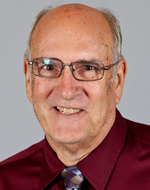 2017 Shugrue Award winner Gary Koppelman believes that the development of community relationships and making positive decisions impacting the world begins in the classroom where students learn truths as owners of their community and the environment around them. As an elementary science teacher at Blissfield Elementary School in Blissfield, MI, he allows students to find solutions and experience imaginative possibilities, generating autonomous thinkers. Students learning creative classroom solutions can find answers to world problems.
2017 Shugrue Award winner Gary Koppelman believes that the development of community relationships and making positive decisions impacting the world begins in the classroom where students learn truths as owners of their community and the environment around them. As an elementary science teacher at Blissfield Elementary School in Blissfield, MI, he allows students to find solutions and experience imaginative possibilities, generating autonomous thinkers. Students learning creative classroom solutions can find answers to world problems.
Koppelman takes a “hands-on, minds-on” approach to teaching and experiential learning. His classroom has various creative biomes, taking students around the world daily. The BELL, connected to his classroom, is a climatically controlled greenhouse at the cutting edge of life-science investigation. It is furnished with various habitats for observation and experimentation as students research and examine plants and animals.
Allowing students to experience science in a cross-curricular manner builds self-confidence in social and academic areas, making connections and learning in unique ways. Jerry Johnson, Superintendent of Blissfield Community Schools, says, “Mr. Koppelman is a recognized leader within our district and throughout the region, lending his skills and knowledge as a Master Teacher, Curriculum Leader, and guest speaker. He has traveled abroad, spoken to world leaders, and been recognized with multiple awards and recognition such as the Shell Science Teaching Award and the Presidential Award for Excellence in Mathematics and Science Teaching.”
 2017 Shugrue Award winner Gary Koppelman believes that the development of community relationships and making positive decisions impacting the world begins in the classroom where students learn truths as owners of their community and the environment around them.
2017 Shugrue Award winner Gary Koppelman believes that the development of community relationships and making positive decisions impacting the world begins in the classroom where students learn truths as owners of their community and the environment around them.
By sstuckey
Posted on 2017-04-20

Steve Hillebrand, US Fish and Wildlife Service
The proposed wall along the U.S.-Mexico border would significantly affect wildlife (see “On the web”). Most animals cannot get past walls that are hundreds of miles long and many meters tall. Some species along parts of the border where a wall already exists, such as jaguars and ocelots, suffer from dwindling populations and difficulty finding mates.
Daily access to food and water can be disrupted by walls, and wildlife populations need to migrate freely to find viable habitat as climate conditions change. Researchers worry that an expanded wall would increase the number of threatened and endangered species requiring protection under the U.S. Endangered Species Act.
Besides walls, other human activities fragment wildlife habitat, including, for example, building houses in a forest, converting tallgrass prairie to cornfields, and laying highways along mountainsides. While such activities may not always substantially shrink the overall size of a habitat, they do break it into smaller, more isolated fragments.
Fragmentation disrupts plants and animals alike. When plans arose to expand the border wall in 2006, Arizona park and wildlife managers’ pointed out that “…building a wall, along with the roads and support facilities it necessitates, would not only plow under saguaros and other fragile desert plants but scare Sonoran pronghorn and other wildlife from important sources of food and water” (Cohn 2007).
Border walls going up in other parts of the world are having similar effects. A study in Slovenia found that the over 100 miles of fence built along the border with Croatia has fragmented habitat for large carnivores, such as wolves, bears, and lynx, which rely on intact territories. “These fences represent a major threat to wildlife because they can cause mortality, obstruct access to seasonally important resources, and reduce effective population size” (Linnell et al. 2016).
Classroom activities
To start, have students read an online article with photographs and a video about wildlife and border walls (see “On the web”). Next, in Modeling the Effects of Habitat Fragmentation, students pose as members of the Habitat Fragmentation task force. They determine specific effects of habitat fragmentation on four animal species using provided data (see “On the web”). In a lesson from Penn State, students learn about the key components of habitat and the suitability of habitats for particular wildlife species.
If you can dedicate a full week to habitat fragmentation, I recommend the Ecological Society of America’s lab activity. Students are introduced to concepts of fragmentation and species assemblages (nestedness) with a focus on birds breeding in forest fragments. The lab activity culminates with poster presentations (see “On the web”).
As the planned border wall takes shape, many wildlife species will be watching.
Amanda Beckrich (aabeckrich@gmail.com) is the Upper School assistant director, International Baccalaureate (IB) diploma program coordinator, and an environmental science teacher at Christ Church Episcopal School in Greenville, South Carolina.
On the web
Biodiversity and fragmentation lab: http://bit.ly/2ldcfb6
Border wall and wildlife articles: http://wapo.st/2lY9xum, http://wapo.st/2mz95PX, http://bit.ly/2kTsewt, http://bit.ly/2jVJsZL
Ecological Society of America’s lab activity: http://bit.ly/2lnxSq7
Modeling the effects of habitat fragmentation activity: http://bit.ly/2lnsVh8
Penn State College of Agricultural Sciences wildlife habitat activity: http://bit.ly/2lnsyTL
Wildlife article and video: http://bit.ly/2kZzQkx, http://bit.ly/2lnO1f5
References
Cohn, J.P. 2007. The environmental impacts of a border fence. BioScience 57 (1): 96. https://doi.org/10.1641/B570116
Linnell, J., A. Trouwborst , L. Boitani, P. Kaczensky, D. Huber, S. Reljic, et al. 2016. Border security fencing and wildlife: The end of the transboundary paradigm in Eurasia? PLoS Biol 14 (6): e1002483. http://bit.ly/Slovenia-habitat
Editor’s Note
This article was originally published in the April 2017 issue of The
Science Teacher journal from the National Science Teachers Association (NSTA).
Get Involved With NSTA!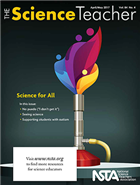
Join NSTA today and receive The Science Teacher,
the peer-reviewed journal just for high school teachers; to write for the journal, see our Author Guidelines, Call for Papers, and annotated sample manuscript; connect on the high school level science teaching list (members can sign up on the list server); or consider joining your peers at future NSTA conferences.

Steve Hillebrand, US Fish and Wildlife Service
*LAST CHANCE! This product is not eligible for return or exchange. All sales are final.*
*LAST CHANCE! This product is not eligible for return or exchange. All sales are final.*
*LAST CHANCE! This product is not eligible for return or exchange. All sales are final.*
*LAST CHANCE! This product is not eligible for return or exchange. All sales are final.*